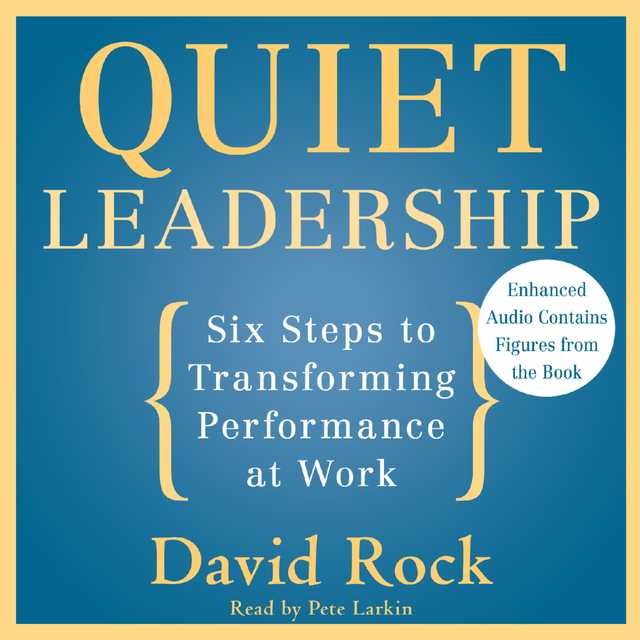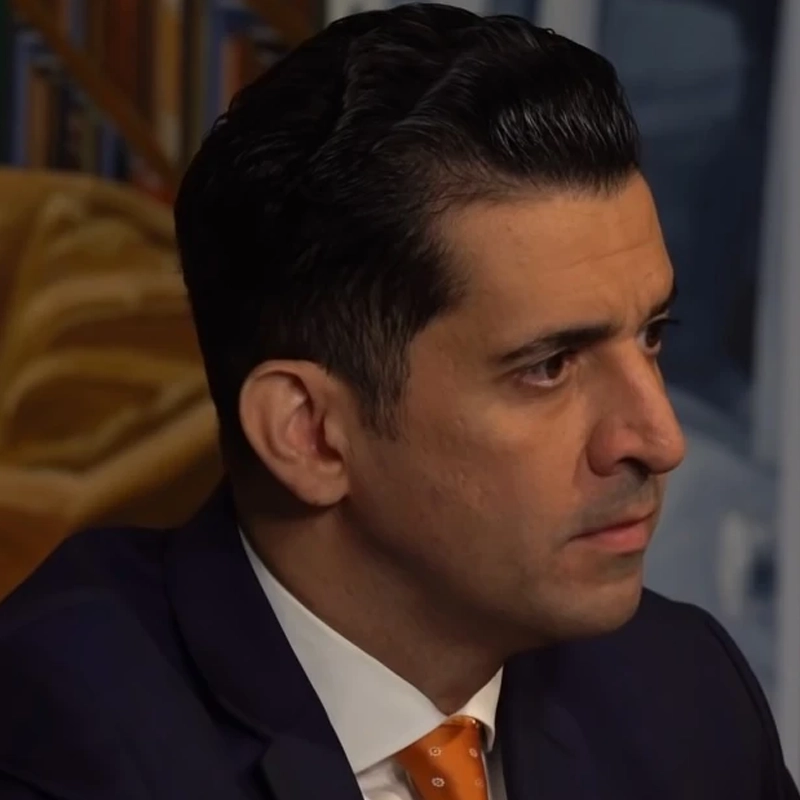Quiet Leadership Audiobook Summary
Improving the performance of your employees involves one of the hardest challenges in the known universe: changing the way they think. In constant demand as a coach, speaker, and consultant to companies around the world, David Rock has proven that the secret to leading people (and living and working with them) is found in the space between their ears. “If people are being paid to think,” he writes, “isn’t it time the business world found out what the thing doing the work, the brain, is all about?” Supported by the latest groundbreaking research, Quiet Leadership provides a brain-based approach that will help busy leaders, executives, and managers improve their own and their colleagues’ performance. Rock offers a practical, six-step guide to making permanent workplace performance change by unleashing higher productivity, new levels of morale, and greater job satisfaction.
Other Top Audiobooks
Quiet Leadership Audiobook Narrator
Pete Larkin is the narrator of Quiet Leadership audiobook that was written by David Rock
David Rock is a consultant and leadership coach who advises corporations around the world. The author of Coaching with the Brain in Mind, Quiet Leadership, and Personal Best, he is the CEO of Results Coaching Systems, a leading global consulting and coaching organization. He is on the advisory board of the international business school CIMBA and the cofounder of the NeuroLeadership Institute and Summit. He lives in Sydney, Australia, and New York City.
About the Author(s) of Quiet Leadership
David Rock is the author of Quiet Leadership
More From the Same
- Author : David Rock
- Your Brain at Work
- Your Brain at Work, Revised and Updated
- Publisher : HarperAudio
- Abraham
- American Gods [TV Tie-In]
- Dead Ringer
- House of Sand and Fog
- Prey
Quiet Leadership Full Details
| Narrator | Pete Larkin |
| Length | 6 hours 57 minutes |
| Author | David Rock |
| Publisher | HarperAudio |
| Release date | November 15, 2011 |
| ISBN | 9780062133076 |
Additional info
The publisher of the Quiet Leadership is HarperAudio. The imprint is HarperAudio. It is supplied by HarperAudio. The ISBN-13 is 9780062133076.
Global Availability
This book is only available in the United States.
Goodreads Reviews
Jim
February 19, 2015
This is a coaching book that begins by looking at some science surrounding the human brain and then uses insights from that and gives leaders a 6 step framework in coaching people through their decisions, difficulties and every day situations. Rock proposes that most people do not need to be told what to do but could use help in thinking through the things they face and, in doing so, the coach helps the person come to their own conclusions and insights which enable them to reform their work habits and more.If your job requires you to lead people, there are definitely concepts in here that are worth your time and consideration.
Sergey
July 17, 2019
I very much like the idea of focusing on the other person's thinking instead of offering my own solutions (which I currently can't resist doing). Continuous asking for permission and placement dialogs are very useful too.
Briana
June 23, 2020
Likes: Fascinating approach to how we can help people think better by utilizing neurological techniques. I read this as part of a coaching course I am in the process of completing. The author David Rock and all his work is brilliant (See: Your Brain At Work). Dislikes: This book is very content heavy (took me almost 3 weeks to read by picking up and letting it down again)Recommend For: Managers, parents, coaches, mentors, Learning and Development professionals
Ming
January 21, 2023
Sexy as fuck
Erika
March 14, 2020
I am always reluctant to give books 5/5 because I worry that someday I will come across the most excellent book ever and not have a higher score to give it. If that day comes, I'll deal with it. Until then, this book deserves a 5/5 for its wealth of information and potential for a positive impact on my life.Quiet Leadership is a book about communication. The core idea is that the best leaders are those who help others to think for themselves. This would amount to nothing more than common sense advice if it weren't for the way Rock backs this up with a process for helping get others to think for themselves. Although the book claims to have 6 steps to help improve your communication skills, each step is actually broken down into multiple parts, so it is probably more like one to two dozen small ideas which group into broader skills.It is that level of detail which makes this book work so well for me. I will need to reread parts of this book several times before they start to get dry, and I am going to have to invest real time and effort into effectively using the techniques Rock presents. This isn't another magic bullet communication book.I'm not going to bother with an overview of the content. The table of contents (which you can see on Amazon) provides as good an overview as I would give here, and the details are too numerous to make sense without reading the book. Instead, if you are interested in effective communication techniques, read it!
Chelsea
June 30, 2014
Good book for anyone in a role working with people, whether direct reports, peers, friends, business partners or family members. The book is geared towards altering your thinking and engagement techniques to be less about self and more about others. There are great processes laid out in the book for conversations and excellent lists of questions and approaches to use. I've been applying the Dance of Insight technique (permission, placement, questioning and clarifying) to those I work with and it's been going positively. Would recommend to those looking to grow themselves and others especially in conversation, thinking and performance improvement.
Roger
July 10, 2008
This book was made for people like me. There are times when I feel that I know how to get someone to do better, but I wasn't comfortable with barking at them. They didn't need a push, they needed a pointer.It is filled with enough common sense to be a breezy read, yet has enough pertinent examples and points to lock in ideas. I passed over the whizbang of neuroscience, as it seemed geared for illuminating commoner folk. The mechanics of changing people's thoughts was more relevant to my interests.
Rebecca
January 06, 2020
I read this book as part of a book club for work, and that must have been one of the best ways to process this material. Like most leadership/self help books, this one is easy to speed through, set aside and walk away from, unless you actively do something with the content.So, what can you do with this? Rock spends a decent amount of time talking about the workings of the brain, justifying his (not yet presented) theories with decades of research, his own dazzling experience, yada yada. This section is not worse than other books in the same genre, though, and as long as you skim over the more "wannabe scientific" parts (like when he draws a chart, sets an arbitrary scale of 0 to 10, places an arbitrary marker halfway to denote some kind of change, and says, "hey, 5 points is actually quite a good improvement!" *facepalm*) it sets a pretty good scene for what the book wants to accomplish.As for the core content, I'd say it's presented in a quite clear manner, with a good mixture of explanations and (make-believe) sample conversations to drive home the message in each section. As with all behavioural changes, you need to go away and do stuff to actually learn anything, but the text leaves you with pretty good guidelines on what to actually do, and I find that the ideas seem to work pretty well at least for getting you counterpart more engaged in conversations and problem solving. Overall I think this has been an enjoyable read, and I definitely believe integrating this into my behaviour will make me a better leader.I'd say, though, that Rock should try to go a bit more chill on the emphasized models and funky abbreviations. There must be at least 10 of them in this book and it makes tying the whole together a bit difficult, plus towards the end I find I'm pretty fed up with having to internalize yet another circuit/table/process chart or whatever. But there are some helpful summarizing chapters towards the end that help with seeing how this all fits together.Finally, a big gold star to Rock for not spending half the book promoting his own services/seminars/master classes. Some of these books are like paying for an advertisement leaflet. This one is not.
Angus
September 22, 2018
One of the recommendations from a work leadership course, I wanted to take this slowly to absorb and 'practise' the content as I went. Probably I went too slow and lost continuity with it, and it didn't become compelling as a read as a result, but I do feel this has excellent content and captures well how I would like to lead and be led. To make this work I will need to revise it, but the points that have stuck with me are: 1. Staying solution focused; 2. Coaching isn't for every situation; 3. Ask permission (I don't do this enough); 4. Ask lots of thinking questions to help others have their 'aha' moment.I have seen/heard objections to this approach. One colleague thinks coaching takes too much time because in part people aren't used to being coached and just want to be told. In response, if I am going to be leading others in a senior role for the rest of my career, there's time enough. I also feel tension with my need to pass on technical expertise to younger colleagues (via teaching) and ensuring they are becoming self learners and self motivated (via coaching). This will take some wisdom to decide on, because there is a role for both, at least at the moment, but I feel it will be the latter that has to prevail if a choice is required, since the world is too complex for me to try and advise others on how to do what they need to do - I get to work with bright, capable people, so I am confident that coaching will help them find better solutions than I would find for them.Lots to learn here, and I hope I can!
Chuck
July 02, 2017
I started reading this book in October 2015. I lost it, found it, and have been plodding through it ever since. Plodding, not because it is a bad book (I really liked it) but because it is about thinking, and that is a very hard thing to do!David Rock has written a book about the latest research on the brain and how it works. He has taken that research and applied it to coaching in the business field. Essentially he has created a format for talking with employees, direct reports, and any one you are leading. This format gives you a structure for teaching your people how to work out problems they are facing without you giving all the answers.I am not a business coach, I have no direct reports or employees, but because I am old I have people seeking advise from me. They may be my children, members of groups I belong to, or friends who see some wisdom in me. I have seen some of these methods used on me by my mentor and it has caused me to think things out for myself which, according to the book, creates new neural pathways to help you/me be more creative in future situations where we might have to think.This is one of the most interesting books I have read in the business coaching field and I hope you will study it yourself. Thinking is hard, but I think you can do it with this creative approach!
Tiffany
January 20, 2019
I found this book incredibly fascinating.Don’t let the title of the book shy you away from reading it. A great deal of brain science is involved in this work, discussing the neural pathways in our brains related to habits and the most powerful ways to create new pathways/habits, especially in regards to our ability to think.Rock discusses the importance of solution focused conversations rather than getting lost in the problem or details of a situation. As someone who will always be an instructional coach at heart, I found the ideas to help transform thinking to be extremely powerful, particularly the thinking questions, how to avoid giving advice, and how to give powerful feedback. I also enjoyed the exercises throughout the book—it provided me with opportunities to put the skills into practice and reflect over what it felt like, and honestly, the slowing down and thinking about how I respond to people, and reflecting over those conversations has been extremely beneficial and powerful, even.Toward the end of the book, there was a chapter on using the 6 steps with teenagers, which if I need this in any area of my life, it’s certainly as a parent with 3 girls, ages 10, 13, and 15, so thank you David Rock for including that important chapter.
Ryan
May 15, 2019
If there were more stars to give, I'd give them all to the author of this book.It is a simply brilliant, outstanding book which details the necessary skills for the leadership of the current times. To help your employees develop their thinking, the author shows the neuroscience of how our brain reacts to the perception of feedback and what we can do to actually put it into practice. With examples which document possible dialogue in situations of good performance, below par performance and poor performance, Mr. Rock does this world a tremendous service by going in depth on all these aspects. The models he provides, particularly the concepts of permission, placement and questionning simply what is a daunting task, i.e. managing and leading people.An outstanding book. Recommended for all leaders, managers and HR people.
Shrinivas
January 02, 2021
Book#1/2021 - Quiet Leadership by David Rock - Help People Think Better - Dont Tell Them what to doTakeaway - As a leader during talks with people - encourage them to think (rather than giving ready solutions), listen with utmost attention (without self -chatter), follow SCARF Model ( Status is about relative importance to others. Certainty concerns being able to predict the future. Autonomy provides a sense of control over events. Relatedness is a sense of safety with others - of friend rather than foe. Fairness is a perception of fair exchanges between people), encourage thinking through various alternatives/options, last but not the least cement the new awareness.In essence follow Coaching as a leadership skill
Joni
October 08, 2017
I read this book as a part of a coach course. This book is full of information and ideas.The book explains with detailed examples how to use six steps. Most pf the chapters end up with practice questions or self reflection moments before diving deeper into the subject.There is enough repetition to help you to remember the main points, but same idea is usually explained with other words. This way reader can absorb ideas better.This is excellent book.However, because it contains so much information it takes a lot time to read through because you have to stop and think before reading further. It took five weeks for me to finish this book.
Hannamari
April 11, 2018
It’s easier for the human brain to build new connections than to change old ones. This is the basis that this leadership / coaching guide is built on. There are some interesting implications, like letting go of ”constructive” criticism that only strenghtens old bad connections, and rather focus on facilitating new positive insights. I appreciate the way this book used memore rules and simple models to explain (and help recall) its techniques, and how all learnings piled into one big framework (works for a visual learner like myself).I’d recommend this read especially to people learning coaching, whether managers, mentors or just great friends.
Most Popular Audiobooks
Frequently asked questions
Listening to audiobooks not only easy, it is also very convenient. You can listen to audiobooks on almost every device. From your laptop to your smart phone or even a smart speaker like Apple HomePod or even Alexa. Here’s how you can get started listening to audiobooks.
- 1. Download your favorite audiobook app such as Speechify.
- 2. Sign up for an account.
- 3. Browse the library for the best audiobooks and select the first one for free
- 4. Download the audiobook file to your device
- 5. Open the Speechify audiobook app and select the audiobook you want to listen to.
- 6. Adjust the playback speed and other settings to your preference.
- 7. Press play and enjoy!
While you can listen to the bestsellers on almost any device, and preferences may vary, generally smart phones are offer the most convenience factor. You could be working out, grocery shopping, or even watching your dog in the dog park on a Saturday morning.
However, most audiobook apps work across multiple devices so you can pick up that riveting new Stephen King book you started at the dog park, back on your laptop when you get back home.
Speechify is one of the best apps for audiobooks. The pricing structure is the most competitive in the market and the app is easy to use. It features the best sellers and award winning authors. Listen to your favorite books or discover new ones and listen to real voice actors read to you. Getting started is easy, the first book is free.
Research showcasing the brain health benefits of reading on a regular basis is wide-ranging and undeniable. However, research comparing the benefits of reading vs listening is much more sparse. According to professor of psychology and author Dr. Kristen Willeumier, though, there is good reason to believe that the reading experience provided by audiobooks offers many of the same brain benefits as reading a physical book.
Audiobooks are recordings of books that are read aloud by a professional voice actor. The recordings are typically available for purchase and download in digital formats such as MP3, WMA, or AAC. They can also be streamed from online services like Speechify, Audible, AppleBooks, or Spotify.
You simply download the app onto your smart phone, create your account, and in Speechify, you can choose your first book, from our vast library of best-sellers and classics, to read for free.
Audiobooks, like real books can add up over time. Here’s where you can listen to audiobooks for free. Speechify let’s you read your first best seller for free. Apart from that, we have a vast selection of free audiobooks that you can enjoy. Get the same rich experience no matter if the book was free or not.
It depends. Yes, there are free audiobooks and paid audiobooks. Speechify offers a blend of both!
It varies. The easiest way depends on a few things. The app and service you use, which device, and platform. Speechify is the easiest way to listen to audiobooks. Downloading the app is quick. It is not a large app and does not eat up space on your iPhone or Android device.
Listening to audiobooks on your smart phone, with Speechify, is the easiest way to listen to audiobooks.













![Abracadaver [Dramatized Adaptation]](https://speechify.com/audiobooks/wp-content/uploads/sites/29/2023/06/pr_eaudio_9781648794001_640px.jpg)
















